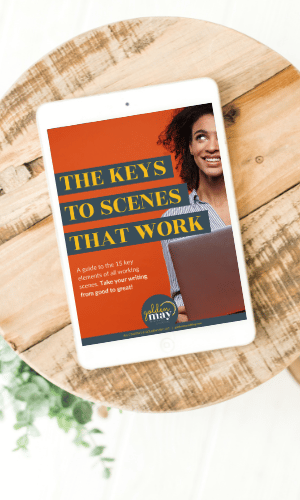Readers are most intrigued by characters that make choices. We’re less interested in what happens to a character than we are what the character is going to do about it.
One of the most common mistakes writers make while outlining is in using plot events to shove a character into and out of the ‘upside down’ world of Act Two, rather than giving them the choice to step into the journey on their own. By doing this, we rob characters of agency, and therefore dull their internal character arcs.
Effective act breaks are internal. Characters must choose to step into Act Two for the wrong reasons, then into Act Three for the right reasons—highlighting just how much they’ve changed.
What’s a character arc?
Stories are about change. A character with a specific flawed belief that we call their Internal Obstacle comes up against plot events designed to test that belief. As they make mistakes because of their Internal Obstacle, the consequences pile up, eventually forcing them to dismantle their flawed belief. At this point, they adopt a more sound belief that we call the Story Point. This trajectory of change is called a positive character arc.
THE HUNGER GAMES: Katniss opens the story believing that Survival, of self and family, is the only reasonable goal (Internal Obstacle). By the end of her character arc, she learns that There are goals more worthy and important than simply surviving (Story Point).
AN EMBER IN THE ASHES: Laia of Serra opens the story believing Some people are inherently strong, others are inherently weak (Internal Obstacle). By the end of her character arc, she learns that Your power lies in your hands, and your hands only (Story Point).
Mapping out internal act breaks
In Act One, you should throw some unexpected plot challenge at your main character, something they can’t avoid or ignore.
Act Two starts when they finally decide HOW they’re going to confront the plot challenge. The plan they form should be influenced by their Internal Obstacle, and therefore flawed. As they implement the plan through Act Two, making bad decisions in each scene, the negative consequences of their choices should pile up until the end of Act Two where they’re forced to face the fact that maybe they (and their Internal Obstacle specifically) are in their own way.
Act Three starts when the character has, as a result of their mistakes in Act Two, changed their outlook on the world. They enter Act Three with a new, sound plan influenced by their new Story Point belief.
These act breaks are internal for a reason. By entering and exiting with flawed and sound beliefs respectively, you will show how deeply your character has changed.
THE HUNGER GAMES: In Act One, Katniss volunteers for the Hunger Games (a televised children’s fight to the death) to save her sister.
Act Two starts when she and another competitor, Peeta, show ‘solidarity’ in a fashion show and get massive public attention. Katniss realizes she might have a chance to win the Hunger Games. Unfortunately, because of her Internal Obstacle belief that survival is the only worthy goal, she can’t see Peeta as an ally to make a statement about the system. She can only see him as an adversary. Her Act Two plan is instead to play along with their ’team’ just enough to win the games alone.
Act Three starts after Katniss’s attempts to survive on her own end in the death of her friend—a friend who reminds her of the sister she’s been trying to protect. She learns the Story Point that there are goals more worthy and important than simply surviving. When the game officials announce TWO kids can win, she sets off to save Peeta as well as herself, rather than try and survive on her own.
AN EMBER IN THE ASHES: In Act One, Laia’s family is raided by their oppressors, her grandparents are killed and her brother is captured. Laia escapes and runs.
Act Two starts when Laia finds the underground Resistance effort and asks for their help saving her brother. They agree, but only if she will pose as a slave and spy for them. Because Laia believes she’s inherently weak, she agrees to put herself in danger to spy, rather than try and save her brother on her own.
Act Three starts after Laia learns the Resistance lied to her about her brother’s whereabouts. She learns the Story Point that she holds her own power and she should have trusted herself all along. She steps into Act Three planning to save her brother with or without the Resistance’s help.
Plot events vs. Character choices
In every story there should be plot twists that throw the main character off the path of their goals—this is what gets readers’ hearts pumping and pages turning! But it’s equally, if not more, important that the character is given the chance to consciously act in the face of those twists. Agency is key to engaging readers.
For an effective character arc, we need to see a character making flawed decisions at every turn. We need to see how those decisions result in negative consequences that plummet them to that dark moment when they have to reckon with themselves and finally face their own potential to change.
The Inciting Incident, or Catalyst, of your story happens in the middle of Act One. This is often a plot event that’s out of the character’s control. It’s Katniss’s sister getting chosen for the Hunger Games. It’s Laia’s grandparents getting murdered and her brother captured. In both of these moments, the character’s make split second decisions—Katniss volunteers, Laia runs. But these choices are nearly involuntary.
The Act Two break occurs when the character consciously decides how they’re going to handle their new circumstances. Katniss decides to try and win the Games on her own. Laia agrees to spy in exchange for help from strangers to free her brother. These choices prove how deep their Internal Obstacles go.
The All Is Lost moment of your story—that awful, rock bottom failure—happens near the end of Act Two. This is often a plot event that occurs that’s a) out of the character’s control, and b) at least partially their fault. Katniss’s ally and friend Rue dies because Katniss was too focused on surviving by herself. Laia learns that the strangers she trusted with her brother’s life never intended to help her save him. It’s the fact that it is THEIR FAULT that allows them to see themselves as the problem and change their beliefs. Katniss learns there are more important goals than just surviving. Laia learns she should have trusted herself.
The Act Three break occurs when the character consciously decides how they’re going to move forward after their gargantuan failure. Katniss decides to help save Peeta instead of just herself. Laia chooses to save her brother on her own. These choices prove how much they’ve changed.
In Conclusion
Character arcs are trajectories of internal change, and internal change is best exemplified through how a person’s choices shift. By tying your act breaks to choices, you can show your character’s growth effectively.








Hello, I loved this article. I was wondering. If I could get access to the free Download: Cheatsheet: plan your act breaks? There didn’t seem to be a link?